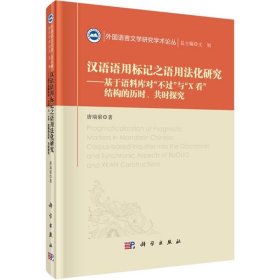
汉语语用标记之语用法化研究:基于语料库对“不过”与“X看”结构的历时、共时探究:corpus-based inquiries into the diachronic and synchronic aspects of BUGUO and XKAN constructions
正版保障 假一赔十 可开发票
¥ 33.38 4.3折 ¥ 78 全新
库存19件
广东广州
认证卖家担保交易快速发货售后保障
作者唐瑞梁著
出版社科学出版社
ISBN9787030448347
出版时间2015-06
装帧精装
开本32开
定价78元
货号8543564
上书时间2024-09-13
- 最新上架
商品详情
- 品相描述:全新
- 商品描述
-
目录
Contents
丛书序i
前言iii
Chapter One Introduction1
1.1 Rationale for the Present Research5
1.2 State of the Art and Problems9
1.2.1 Previous Researches on Diachronic Evolution of BUGUO and XKAN9
1.2.2 Previous Researches on Synchronic Aspects of BUGUO and XKAN13
1.2.3 Why Diachronic?16
1.2.4 Interim Summary22
1.3 Diachronic Work Relevant to This Book24
1.3.1 Grammaticalization24
1.3.2 Pragmaticalization31
1.3.3 Models of Semantic Change36
1.4 Data and Methodology46
1.4.1 Values of Corpus-based Research46
1.4.2 The Data47
1.4.3 Methodology for the Analysis50
1.5 Objectives of the Present Study52
1.6 Outline of the Book55
Chapter Two Pragmatic Functions of BUGUO: A Synchronic Analysis57
2.1 Data and Methodology59
2.2 Use and Functional Distribution of BUGUO in the Corpus60
2.3 Pragmatic Functions of BUGUO63
2.3.1 Metalinguistic Functions63
2.3.2 Metacommunicative Functions72
2.4 The Relationship Between the Core Meaning of BUGUO and Its Pragmatic Functions82
Chapter Three Pragmaticalization of BUGUO: A Diachronic Analysis87
3.1 Data, Distribution of BUGUO and Methodology88
3.2 Main Meanings of GUO91
3.3 Historical development of BUGUO93
3.3.1 BUGUO in Old Chinese94
3.3.2 BUGUO in Middle Chinese107
3.3.3 BUGUO in Old Mandarin111
3.3.4 BUGUO in Middle Mandarin119
3.4 Pragmaticalization of BUGUO124
3.5 Motivations and Mechanisms Involved in the Pragmaticalization of BUGUO127
3.5.1 Motivations for the Pragmaticalization of BUGUO127
3.5.2 Mechanisms of the pragmaticalization of BUGUO135
3.6 Accompanying Changes of the Pragmaticalization of BUGUO148
3.6.1 Phonological Changes148
3.6.2 Semantic Changes149
3.6.3 Syntactic Changes152
Chapter Four Pragmatic Functions of XKAN: A Synchronic Analysis154
4.1 Data and Methodology155
4.2 XKAN: PM Use vs. Non-PM Use156
4.3 Use and Distribution of WOKAN and NIKAN in the Corpus160
4.4 Pragmatic Functions of WOKAN164
4.4.1 Self-quotation164
4.4.2 WOKAN as a Hesitation Marker170
4.5 Pragmatic Functions of NIKAN174
4.5.1 NIKAN as an Attention Getter176
4.5.2 NIKAN as a Coherence Builder178
4.5.3 NIKAN as a Politeness Marker182
4.5.4 NIKAN as a Turn Yielder184
4.6 XKAN as Markers of Interpersonal Involvement186
4.6.1 “Involvement” in the Present Study186
4.6.2 Discussion188
Chapter Five Pragmaticalization of XKAN: A Diachronic Analysis190
5.1 Distribution of WOKAN and NIKAN and Methodology191
5.2 Core Meanings of KAN192
5.3 Historical Development of XKAN194
5.3.1 Historical Development of WOKAN194
5.3.2 Historical Development of NIKAN206
5.4 Pragmaticalization of XKAN218
5.5 Motivations and Mechanisms Involved in the Pragmaticalization of XKAN221
5.5.1 Motivations for the Pragmaticalization of XKAN221
5.5.2 Mechanisms of the Pragmaticalization of XKAN226
5.6 Accompanying Changes of the Pragmaticalization of XKAN234
5.6.1 Phonological Changes234
5.6.2 Semantic Changes235
5.6.3 Syntactic Changes236
Chapter Six Historical Development of BUGUO and XKAN: Cases of Pragmaticalization238
6.1 Traditional Interpretation of the Rise of Pragmatic Markers239
6.2 Historical Evidence from the Evolution of BUGUO and XKAN as Pragmatic Markers244
6.2.1 Grammar vs. Pragmatics244
6.2.2 Discussion249
6.3 Pragmaticalization Reconsidered265
6.3.1 Relationship Between Pragmaticalization and Grammaticalization265
6.3.2 A Morpheme-based Approach to Pragmaticalization268
Chapter Seven Conclusion270
7.1 Review270
7.2 Directions for Future Study276
References279
Appendix: A Brief Chronology of Chinese History295
List of Figures
Figure 1.1 Evolution line of BUGUO in Shen’s research10
Figure 1.2 Model of the IITSC40
Figure 2.1 Functional distribution of BUGUO82
Figure 3.1 BUGUO1 in the Pre-Qin period98
Figure 3.2 A Sketch of the historical development of BUGUO125
Figure 3.3 Functional change in BUGUO’s pragmaticalization126/272
Figure 3.4 General representation of the image schema of GUO130
Figure 3.5 Representation of the image schema of spatial GUO130
Figure 3.6 Representation of the image schema of temporal GUO131
Figure 3.7 Representation of the image schema of GUO followed by abstract concept133
Figure 3.8 Representation of the image schema of standard GUO134
Figure 3.9 The IITSC model in the semantic shift of BUGUO’s pragmaticalization from BUGUO1 to BUGUO2140
Figure 3.10 Semantic changes of BUGUO151
Figure 3.11 Syntactic changes of BUGUO152
Figure 5.1 Semantic-pragmatic functions of WOKAN in Middle Mandarin199
Figure 5.2 Discursive behaviors of NIKAN in the Southern Song Dynasty and the Yuan Dynasty211
Figure 5.3 Functional change in WOKAN’s pragmaticalization219/273
Figure 5.4 Functional change in NIKAN’s pragmaticalization220/273
Figure 5.5 Semantic shifts of KAN in XKAN’s pragmaticalization222
Figure 5.6 Invited inferencing in XKAN’s pragmaticalization231
Figure 5.7 Semantic changes of XKAN235
Figure 5.8 Syntactic changes of XKAN236
Figure 6.1 Pragmaticalization of BUGUO and unidirectionality262
Figure 6.2 Pragmaticalization of XKAN and unidirectionality263
Figure 6.3 Clines of pragmaticalization266
List
内容摘要
Chapter One Introduction
In recent decades, the research on language change has attracted a lot of attention in both functionalist and formalist circles, and one of the newly thriving branches under such a historical study on language change is termed grammaticalization, which focuses mainly on how grammatical categories rise in a language from certain linguistic expressions, usually content words, such as nouns and verbs (Meillet, 1912; Traugott, 1982; Traugott, 1995a, 1995b; Hopper & Traugottt, 2003; Sun & Traugott, 2011, etc.). Research on language change such as grammaticalization has also inspired a growing number of in-vestigations on the historical development of pragmatic markers and other similar linguistic items. However, problems begin to arise when previous scholars try to approach pragmatic markers as they have done to other lin-guistic items from the perspective of grammaticalization.
As we know, the study on pragmatic markers has since the very beginning posed serious problems to linguistic research, especially in syncronic research-es, since these items are traditionally considered non-propositional . The same tough problem happens to the study of the historical formation of pragmatic markers, because these markers and other similar items do not pattern well with the classical cases of grammaticalization study. Although there seems to be a consensus that the rise of pragmatic markers and grammatical categories share to a limited extent certain formal characteristics, it is more surprising to note that the defining features and various changes accompanying the histori-cal evolution of pragmatic markers are rather different from those of gram-maticalization and the intrinsic nature of the diachronic aspects of pragmatic markers are still much under debate because of the complexity of the histori-cal process involved as well as the heterogeneity of the origin of these items. In view of this, some scholars have proposed a new term “pragmaticalization” for this specific historical study.
The present study focuses on the historical development of pragmatic markers in Mandarin Chinese through studying two specific cases: BUGUO (不过) and XKAN (X看). In other words, we try to disclose and investigate the historical processes concerning how these two Mandarin expressions have emerged and developed to function as pragmatic markers from expressions of non-pragmatic origin. Both constructions involve a verb: in BUGUO, GUO (过) means to cross or to exceed and in XKAN, KAN (看) means to see or to look. The verbal use of GUO and KAN can be exemplified in (1) and (2) re-spectively.
(1) 过 马路
(2) 看 电影
What’s more, both constructions have undergone the historical devel-opment from the roots of non-pragmatic origin in Old or Middle Chinese to constructions functioning as pragmatic markers in Present-day Mandarin. The acquired pragmatic functions of these two constructions can be demonstrated in (3) and (4) respectively.
(3) 根本说不清道不明的一个感情纠纷,不过 (BUGUO) 后来她的一段声明,看了以后我很感动 (《鲁豫有约 王纳文泪洒》)
(4) 你姑娘整天求着我们,非要走不行,你看 (NIKAN) 怎么办? (《鲁豫有约 洛杉矶托儿所》)
李红:她啊。当时我看 (WOKAN) 挺生气的,上去就手一拉,就把那个有线广播给关了。 (《鲁豫有约 李红的故事》)
In the examples above, both BUGUO and XKAN function as pragmatic markers. In (3), BUGUO is a pragmatic marker signaling the illocutionary con-trast between the preceding and the following sections of the utterance. Both NIKAN and WOKAN in (4) can be regarded as markers of politeness. More detailed and systematic analyses will be given in Chapters Two and Four of the book. It will be argued in the present research that these pragmatic markers do not have any pragmatic functions in their original forms. Such historical pro-cesses whereby a content word or a consequence of content words of non-pragmatic origin acquires the functions of pragmatic markers are defined as pragmaticalization. In the present research, we will show that pragmatic markers like BUGUO and XKAN above are different from affixes, tenses, etc., which are grammatical categories. Furthermore, we will argue that the evolu-tionary processes of the above two groups of expressions, viz. pragmatic markers and grammatical categories, are not the same. We will try to prove on the basis of the synchronic and diachronic analysis that the former is an in-stance of pragmaticalization while the latter grammaticalization.
Pragmaticalization, together with findings in prior investigations into the historical study of language, forms the basic framework for this study. In order to investigate the exact diachronic processes of BUGUO and XKAN construc-tions, as
相关推荐
— 没有更多了 —




















以下为对购买帮助不大的评价